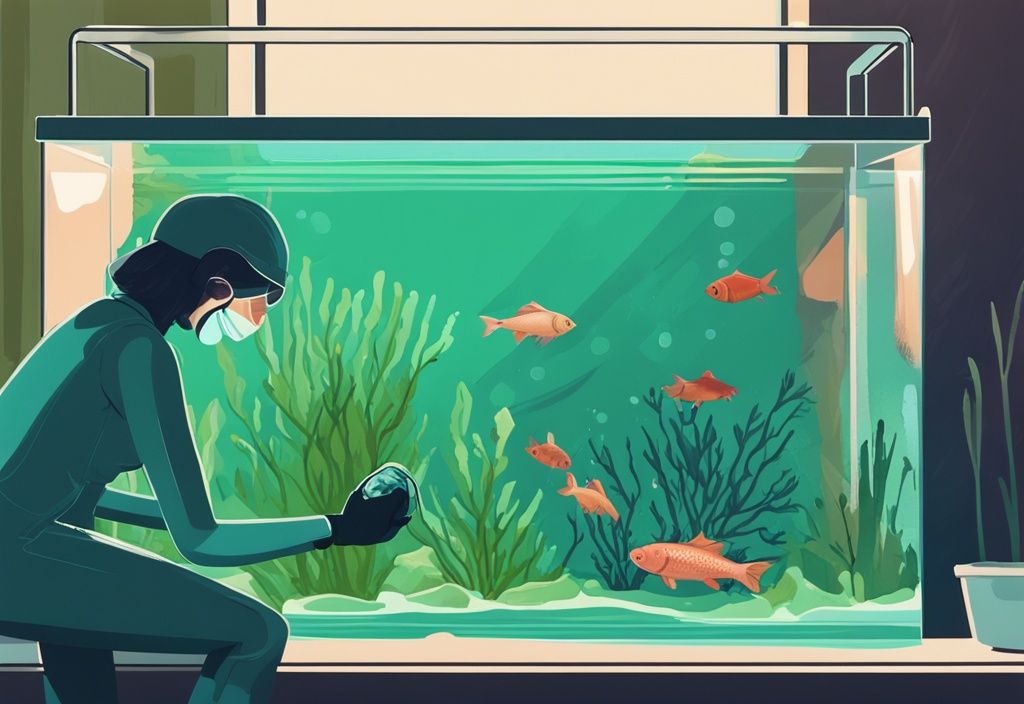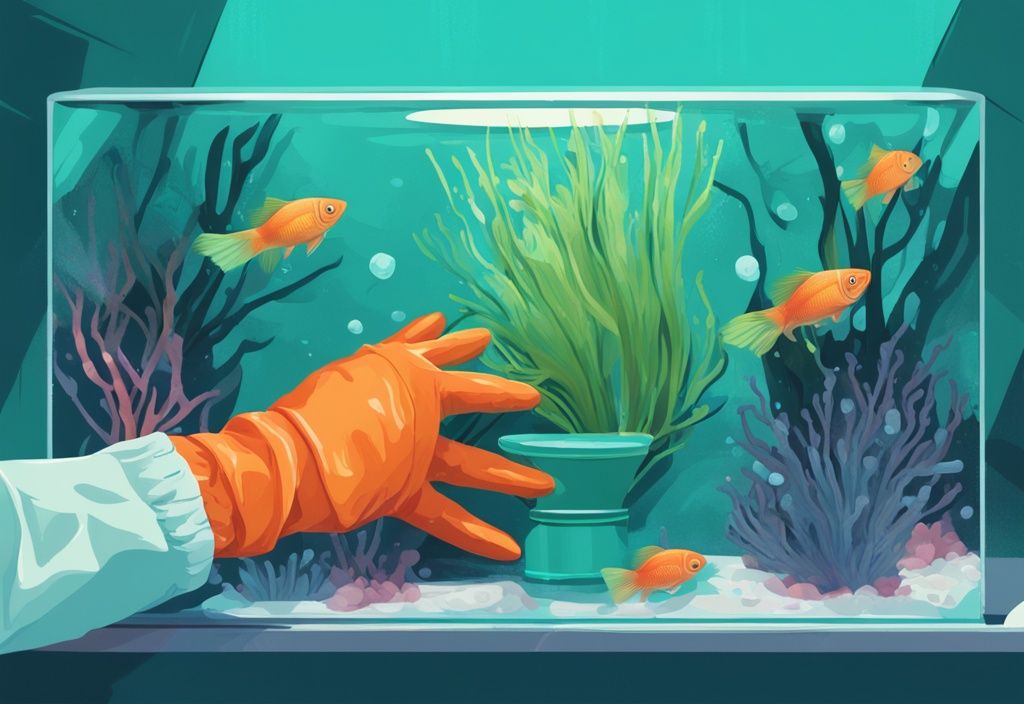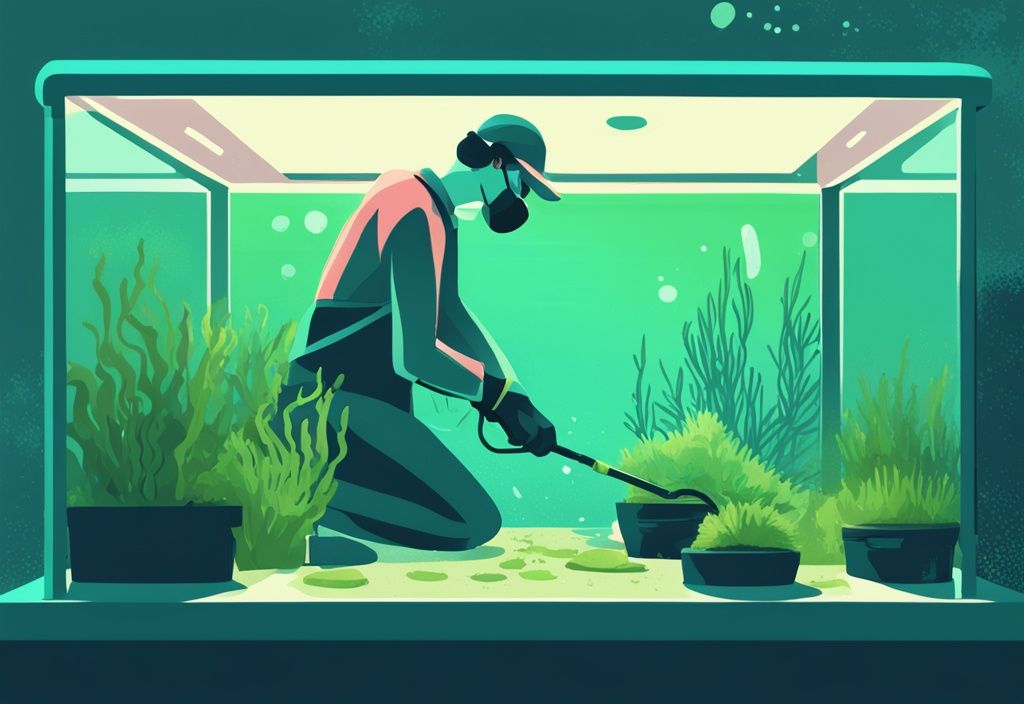Is your vibrant fish tank losing its shine due to the green, brown, or the notorious black beard algae? As an experienced marine biologist, I understand the frustration these stubborn invaders can cause. My mission here is to assist you in restoring the balance of your aquarium ecosystem with a strategic approach to manage algae growth.
Understanding the causes of algae and having the right preventive measures in place can save you a significant amount of time and energy in the long run. Let’s delve into those crucial aspects early on, shall we?
In this comprehensive guide, you will grasp effective techniques to eradicate existing algae and strategies to maintain a clean, healthy aquarium. Ready to dive in for a sparkling, algae-free tank experience? Let’s get started.
Understanding Algae: Causes and Types
Before delving into how to get rid of algae in a fish tank, it’s crucial to understand what causes these tiny organisms to thrive and the variety of algae you might encounter.
What Causes Algae in Fish Tanks?
Algae infestations in fish tanks are a frequent worry for many aquarium enthusiasts. These tiny organisms thrive when water, nutrients, and light are in abundance, making fish tanks an ideal habitat. Several factors can trigger excessive algae growth.
Overfeeding fish can lead to an accumulation of uneaten food and waste, generating high levels of nutrients like phosphorus and nitrogen, which algae love. Poor tank maintenance, such as infrequent water changes, also contributes to the buildup of organic compounds, exacerbating the algae problem. Overexposure to light and irregular water change schedules disrupt the tank’s ecological balance, further promoting algae proliferation. Understanding and addressing these underlying causes is essential for effective algae management.
Common Types of Algae Found in Aquariums
Algae come in various forms, each requiring different management techniques:
- Green Algae: This type is common and usually indicates a healthy tank environment, but it should be controlled to prevent overgrowth.
- Brown Diatom Algae: Often appearing in new tanks, these can be easily removed manually or consumed by certain algae eaters.
- Black Beard Algae (BBA): Resistant to most algae eaters, BBA can be managed with hydrogen peroxide treatments or by introducing Siamese Algae Eaters.
- Hair Algae: Manage this type by reducing light exposure, adjusting fertilization routines, and manual removal. Shrimp and specific algae eaters can also help keep it under control.
- Green Spot Algae (GSA): Caused by excessive light and nutrient imbalances, GSA can be tackled manually using a razor blade or with the assistance of snails.
- Blue-Green Algae (Cyanobacteria): Not true algae, this issue can be mitigated by increasing water circulation, and in some cases, antibiotics may be necessary.
- Green Water: Caused by phytoplankton blooms due to high light and nutrient levels, green water can be treated by reducing light exposure or using UV sterilizers.

Preventing Algae Growth: Tips and Techniques
Discover effective methods to control and prevent algae growth, ensuring a pristine and balanced environment for your aquatic friends.
Maintaining Proper Water Quality
Mastering water quality is key to learning how to get rid of algae in a fish tank. Regularly using water test kits helps in monitoring essential parameters like ammonia, nitrates, and phosphates.
Detecting ammonia is a red flag, often signaling overstocking or overfeeding, which require immediate action. Keeping nitrates low through frequent water changes is crucial. Phosphates, entering through water supplies and fish foods, should be monitored and removed to prevent algae blooms.
Better tank aeration reduces CO2 levels, fostering aerobic bacteria that compete with algae for nutrients, effectively curbing algae growth.
Lighting: The Key to Algae Control
Lighting plays a crucial role in the fight against algae. Assessing and adjusting the tank’s lighting conditions can prevent excessive algae growth. Setting the photoperiod to around eight hours daily using a timer ensures controlled light exposure.
Regular replacement of tank lights is necessary as their spectrum shifts over time, potentially encouraging algae growth. Additionally, positioning tanks away from direct sunlight can prevent the excessive development of algae, as natural sunlight can be too intense and uncontrollable.
How Nutrient Levels Affect Algae Growth
High nutrient levels, particularly nitrates and phosphates, are major culprits in algae growth. Conducting regular water changes helps maintain optimal nutrient levels, essential in understanding how to get rid of algae in a fish tank.
Managing the fish population and controlling feeding practices significantly reduce the nutrient load, thereby limiting algae proliferation. Incorporating phosphate-adsorbing media into your tank setup is another effective method to control phosphate levels, keeping algae at bay.
Effective Methods to Banish Algae
Manual Cleaning Techniques: Ensure a Sparkling Tank
One of the most straightforward methods for dealing with algae is manual cleaning. Begin by using algae pads or scrubbers to physically remove algae from tank surfaces. Regular water changes are crucial, as they help eliminate excess nutrients that fuel algae growth. Scrub all tank decorations, the glass, and the substrate to keep your tank looking pristine and free from algae buildup.
Natural Algae Consumers: Your Hidden Cleaners
Another effective approach to manage algae growth is by introducing natural algae consumers into your tank. Fish and invertebrates like Siamese Algae Eaters, Bristlenose Plecos, Amano Shrimps, and Nerite Snails are excellent choices. These creatures consume algae, significantly reducing its presence in your tank.
Ensure that the chosen algae eaters are compatible with other inhabitants to maintain a harmonious tank environment.

Advanced Techniques for Serious Algae Issues
If algae problems persist despite manual cleaning and the introduction of natural algae consumers, advanced techniques may be necessary. UV sterilizers are highly effective in killing algae spores and preventing their spread throughout the tank.
Using phosphate-adsorbing media can help remove excess phosphates, a key nutrient for algae, from the water. For stubborn algae, consider hydrogen peroxide treatments or other safe chemical treatments. It’s crucial to monitor the effectiveness of each step and make further adjustments as needed to keep your tank algae-free.
Essential Methods to Manage and Prevent Algae Growth in Your Fish Tank
Importance of Regular Cleaning
Regular maintenance is a cornerstone in your quest to eliminate algae in a fish tank. Organic materials like uneaten food and fish waste decompose and release nutrients, creating an ideal environment for algae. Cleaning the filter, decorations, and gravel periodically is crucial to remove these nutrient sources. It’s also important to promptly remove any dead plants or fish to maintain a healthy tank environment. Consistent cleaning routines are crucial steps in understanding how to get rid of algae in a fish tank.
Striking the Right Light and Nutrient Balance
Balancing light and nutrients is key to controlling algae. Excessive light and nutrient overdose can lead to a rapid algae bloom. Tailor light levels to meet the needs of your plants and fish, avoiding overexposure. Controlled feeding and regular water changes help maintain low nutrient levels, thereby reducing algae growth. Achieving the right balance of light and nutrients is an essential component in the comprehensive approach to how to get rid of algae in a fish tank.
Ensuring Proper Filtration and Aeration
Filtration and aeration are vital in managing algae levels. Effective filtration systems remove waste, detritus, and excess nutrients, which contribute to algae proliferation. Proper aeration reduces CO2 levels and fosters beneficial bacteria growth, which competes with algae for nutrients. Investing in a good filtration system and ensuring adequate aeration can make a significant difference in how to get rid of algae in a fish tank.
The Beneficial Role of Aquarium Plants in Algae Control
Aquarium plants can be your best allies in controlling algae growth. They absorb excess nutrients that algae thrive on. Fast-growing plants are particularly effective as they swiftly uptake nutrients, outcompeting algae. Healthy plants also help stabilize the tank environment, making it less favorable for algae. Additionally, they can block some light, inhibiting algae proliferation further. Incorporating live plants is a natural and sustainable method for how to get rid of algae in a fish tank.
Overcoming Algae Problems: Conclusion
Let’s dive into how to get rid of algae in a fish tank through a thoughtful, multipronged approach. Tackling this common issue involves a mix of manual cleaning, natural algae eaters, and diligent maintenance. The effectiveness of algae control relies heavily on physically removing algae from the tank. Imagine brushing away unwanted intruders from your aquatic ecosystem. Regularly clean the glass surfaces, decorations, and substrate to prevent algae from getting a foothold. Tools like algae pads or scrubbers become your best friends in this process.
Next, consider introducing natural algae eaters such as Siamese Algae Eaters, Bristlenose Plecos, Amano Shrimps, or Nerite Snails. Picture these hardworking creatures as your trusty cleaning crew. They not only consume various types of algae but also assist in keeping algae populations in check. Ensuring these algae eaters are compatible with your other tank inhabitants is crucial to prevent any conflicts. Think of it as creating a harmonious community where everyone plays a part.

Addressing the underlying causes of algae growth is just as important. High nutrient levels, improper lighting, and inadequate maintenance are often the main culprits. Regular water changes and the use of phosphate-absorbing media can effectively manage excess nutrients. Adjusting the lighting to avoid overexposure and utilizing timers helps keep algae growth under control.
Conduct frequent water tests to monitor levels of ammonia, nitrates, and phosphates. This enables early detection and correction of any imbalances—a bit like running regular health check-ups on your tank. If you’re interested in maintaining a thriving aquatic environment, consider exploring low light aquarium plants. Patience and consistent care are pivotal. Achieving a balanced aquarium with minimal algae issues doesn’t happen overnight. Ongoing and diligent efforts to maintain water quality, implement corrective measures, and adapt to the specific needs of your tank can lead to long-term success.
This comprehensive approach to how to get rid of algae in a fish tank can transform a troublesome environment into a healthy, beautiful one. It’s all about creating and maintaining a balanced ecosystem where both you and your aquatic friends thrive.
FAQs: Clearing Your Doubts About Algae in Fish Tanks
Why is Algae Growing Rapidly in My Fish Tank?
Imagine your fish tank as a bustling little ecosystem. When algae start to grow uncontrollably, it’s often a sign of imbalance. Overfeeding, excessive light, and high nutrient levels are common culprits. By cutting back on fish food, reducing light exposure, and maintaining nutrient levels through regular water changes, you can combat this issue. Consistency is key—inspect your tank regularly, adjusting as needed to achieve harmony.
Are Algaecides a Viable Solution to Algae Growth?
Algaecides can be a quick fix, but think of them as putting a bandage on a deeper wound. They address the symptom—algae—but not the root cause, like excess nutrients. Long-term use can stress your fish, so use them sparingly. Focus instead on creating a balanced environment, and algaecides will be less necessary.
How Often Should I Clean My Fish Tank to Keep Algae at Bay?
To keep your aquatic world pristine, shoot for a regular cleaning schedule. A partial water change and tank cleaning every 1-2 weeks can work wonders in preventing algae buildup. Don’t forget to rinse your filter regularly and remove any debris. If you’re setting up a small aquarium, consider checking out our list of the 7 best 5 gallon fish tanks to find the perfect fit for your space. This routine helps create a healthy, vibrant, algae-free environment.
Do Algae Eaters Really Help in Controlling Algae?
Absolutely, algae eaters can be your tank’s unsung heroes. Fish and invertebrates that munch on algae can significantly reduce its presence. However, compatibility is crucial—ensure these algae eaters coexist peacefully with your existing fish to avoid any unnecessary stress or conflicts.
Is it Safe to Use UV Sterilizers for Algae Control in My Aquarium?
UV sterilizers act as a kind of microscopic gatekeeper, zapping algae spores as water flows through. They are a safe and highly effective method to keep algae under control. With consistent use, UV sterilizers can remarkably reduce algae recurrence, making your tank a clearer, more welcoming space for your aquatic friends.
